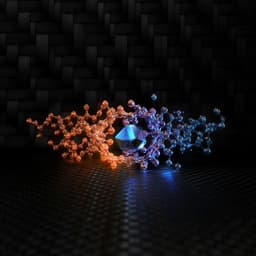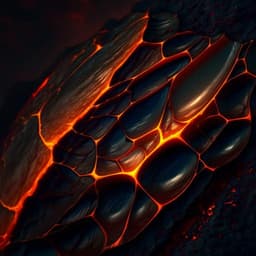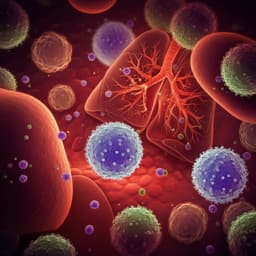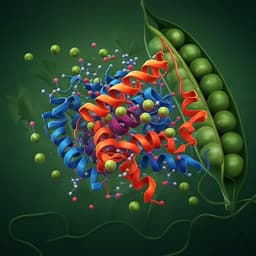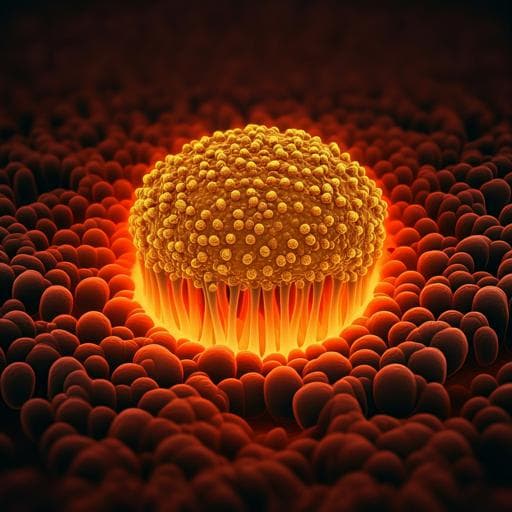
Biology
Life at high temperature observed *in vitro* upon laser heating of gold nanoparticles
C. Molinaro, M. Bénéfice, et al.
Discover how laser-assisted high-temperature microscopy (LA-HTM) is revolutionizing the study of thermophiles, those remarkable microorganisms thriving in extreme heat. Researchers Céline Molinaro, Maëlle Bénéfice, Aurore Gorlas, Violette Da Cunha, Hadrien M. L. Robert, Ryan Catchpole, Laurent Gallais, Patrick Forterre, and Guillaume Baffou showcase this innovative method that leverages gold nanoparticles to reveal the unique behaviors of *Geobacillus stearothermophilus* and *Sulfolobus shibatae* at elevated temperatures.
~3 min • Beginner • English
Introduction
The study explores how to observe and quantify the behavior of thermophilic and hyperthermophilic microorganisms at their high optimal temperatures using standard optical microscopes. Conventional microscope heating systems rarely exceed ~40 °C, limiting in vitro observation of thermophiles. The research aims to develop a simple, rapid, and high-resolution high-temperature microscopy approach that avoids heating the entire microscope and user environment, reduces thermal inertia, and preserves optical performance. By leveraging microscale laser heating and quantitative phase microscopy, the authors seek to enable real-time studies of growth, motility, and spore germination of thermophiles under controlled temperature profiles directly within the field of view.
Literature Review
Early high-temperature microscopy (HTM) approaches relied on resistive heating. Gluch et al. (1994, 1995) introduced Peltier-driven sealed capillary chambers heating up to 100 °C to study hyperthermophile motility. Horn et al. (1999) used a similar heated capillary device to observe cell division. From 2012, Wirth’s group revived HTM with improved heated-capillary systems and a temperature gradient-forming device (TGFD) enabling linear gradients over centimeters, used to study archaeal motility up to 100 °C. Other approaches included hand-made Pyrex chambers on transparent hot plates (Kuwabara et al., 2012) observing anaerobic thermophiles at 65 °C, and the Sulfoscope (Pulschen et al., 2020), which uniformly heated metallic dishes with cap and stage elements to image Sulfolobus acidocaldarius at 75 °C while preventing evaporation and condensation. A major limitation across systems was the need for air objectives and imaging through thick samples. Charles-Orszag et al. (2021) heated the coverslip via a transparent ITO layer up to 75 °C (objective warmed to ≤65 °C), partially lifting this constraint. Overall, prior HTMs were custom-built, had large thermal inertia, limited spatial resolution, and often heated the objective, restricting imaging performance. The present work addresses these gaps via localized laser heating with gold nanoparticles and quantitative phase thermometry.
Methodology
The authors developed a laser-assisted high-temperature microscopy (LA-HTM) platform that locally heats a small region within the microscope field of view by illuminating a gold nanoparticle-coated coverslip with an infrared laser. Gold nanoparticles provide strong, biocompatible photothermal absorption, enabling efficient heating with moderate laser powers (<100 mW). To map temperature, they used cross-grating wavefront microscopy (CGM; quadriwave lateral shearing interferometry) to measure laser-induced refractive index changes and reconstruct 2D/3D temperature distributions. To overcome non-uniform thermal profiles due to diffusion, a spatial light modulator (SLM) shapes the beam (e.g., into a ring) to produce flat temperature plateaus over defined areas. Sample preparation: microbial suspensions were confined between two coverslips with ~15 µm liquid thickness inside a metallic Attofluor dish. Thin layers suppress convection driven by vertical temperature gradients. Because confinement reduces gas exchange, a small hole was drilled in the top coverslip (or an air bubble retained) to maintain oxygenation for aerobes. A top coverslip prevents evaporation and enables multi-day observation and replenishment. Pre-incubation at 60 °C for 1 h prior to imaging was used in some experiments to trigger immediate growth upon laser heating and promote cell adhesion to mitigate thermophoretic drift. Temperature fields were measured by CGM with the laser off-reference subtracted. Dry mass (biomass) was also quantified with CGM by measuring optical thickness and using appropriate referencing. Microscope setup: custom Köhler illumination (625 nm LED), x–y translation, Olympus objectives (60x/0.7 NA air; 60x/1.25 NA oil), CGM camera (QLSI cross-grating, 39 µm pitch, positioned 0.87 mm from an Andor Zyla sensor), sCMOS camera (Hamamatsu ORCA Flash 4.0 V3) for motility videos, 749 nm edge dichroic and 694 nm short-pass filter. An 800 nm Ti:Sapphire laser (Verdi or Millenia pumped Tsunami/Mira cavities) matched the nanoparticle plasmon resonance. The SLM (1920×1152) holograms were computed via the Gerchberg–Saxton algorithm. Heating response time is set by thermal diffusivity and beam size, yielding ~50 ms time scales for ~100 µm beams, enabling near-instantaneous temperature steps. Organisms and assays: Geobacillus stearothermophilus (aerobic, optimal ~60–65 °C) was used to demonstrate growth, motility, and spore germination under shaped temperature fields. Sulfolobus shibatae (hyperthermophilic archaeon, optimal ~80 °C) growth was quantified. Growth measurements used CGM to track biomass of microscale colony forming units (mCFUs) over time under controlled temperature plateaus or gradients, enabling extraction of growth rates and generation times.
Key Findings
- Microscale, flat temperature fields were achieved by shaping the infrared laser into a ring, producing uniform temperatures (e.g., 65 °C) over defined circular areas despite thermal diffusion; outside the heated area, temperature decayed radially (~1/r).
- Geobacillus stearothermophilus exhibited robust, laser-activated growth confined to the heated zone near 65 °C, with markedly reduced growth outside where temperatures fell below ~50 °C. Time-lapse imaging showed sustained growth over hours.
- Growth quantification from CGM-derived biomass revealed exponential growth at all tested temperatures and yielded temperature-dependent growth rates consistent with literature. Fitting with the Cardinal Model gave parameters: G0 = 0.70 ± 0.2 (maximum growth, a.u.), Tmin = 40 ± 4 °C, Topr = 65 ± 1.6 °C, Tmax = 67 ± 3 °C. While temperature parameters were reproducible, G0 varied with medium and microscale culture conditions.
- Bacterial motility: upon establishing a temperature gradient with a uniform beam, individual G. stearothermophilus cells displayed directed swimming within seconds of laser activation, while others remained stationary, indicating rapid thermal response and enabling studies of motility/thermotaxis.
- First real-time observation of G. stearothermophilus spore germination under controlled heating: among 13 spores monitored over ~15 h, 4 germinated at staggered times (e.g., ~2 h, 3 h 10 min, 9 h 40 min, 11 h 30 min), demonstrating stochastic behavior under identical conditions. Post-germination growth rate was 0.77 ± 0.1 h−1, higher than rates observed for vegetative cells in other assays.
- Sulfolobus shibatae growth was sustained near 73 °C (within its active range but below the 80 °C optimum). Biomass increased linearly over time (rather than exponentially), a surprising result potentially due to close packing and growth inhibition at high local density.
- The LA-HTM confines heating to ~tens of micrometers-scale volumes, enabling immediate temperature steps (~50 ms), preserving microscope components (including oil objectives) at room temperature, and allowing multiple temperatures to be probed within a single sample/movie, greatly accelerating experiments.
- CGM provided simultaneous temperature mapping and label-free biomass quantification with sub-picogram precision, avoiding pitfalls of fluorescence-based thermometry at high temperatures.
Discussion
The findings demonstrate that localized photothermal heating of gold nanoparticle-coated substrates, combined with quantitative phase thermometry, enables high-resolution live imaging of thermophiles at their optimal temperatures using standard microscope objectives, including oil immersion. The ability to shape temperature fields in situ allows rapid, precise control of microenvironments, facilitating direct measurement of growth kinetics across temperatures within a single preparation and supporting real-time observations of motility and rare events like spore germination. The approach addresses longstanding HTM challenges: it reduces heated volume (improving spatial resolution and preventing unwanted warming of optics), minimizes thermal inertia (millisecond-scale temperature steps), and decouples user/environmental heating from sample heating. The study validates temperature-dependent growth of G. stearothermophilus consistent with established models and reveals unexpected linear growth in S. shibatae under confined conditions, suggesting microenvironmental constraints on archaeal proliferation. The integration of CGM offers robust, label-free temperature and biomass readouts suited to high-temperature biology where many fluorescent probes are unreliable or unstable. Collectively, the method expands experimental access to the physiology of thermophiles and hyperthermophiles, including dynamic processes like germination and motility, under controlled and quantifiable thermal profiles.
Conclusion
This work introduces a laser-assisted high-temperature microscopy (LA-HTM) strategy that enables safe, simple, and rapid observation of thermophilic microorganisms at high temperatures using accessible optical components. By photothermally heating gold nanoparticle-coated substrates and shaping the beam to produce uniform temperature plateaus, the authors achieved precise microscale thermal control and simultaneous temperature and biomass mapping with CGM. They demonstrated normal growth, motility, and real-time spore germination in Geobacillus stearothermophilus and sustained growth of the hyperthermophilic archaeon Sulfolobus shibatae, with growth kinetics measured directly in situ. The platform overcomes limitations of resistive HTMs, including heating of objectives, large thermal inertia, and restricted resolution. Future research directions include quantitative studies of thermotaxis and motility across controlled gradients, single-cell dynamics of germination and division under varying microenvironmental constraints, optimization of gas exchange and confinement geometries, and exploration of even higher temperatures (>100 °C at ambient pressure) to probe extreme hyperthermophiles and thermally driven biochemical processes.
Limitations
- Cell movement: Non-adherent or swimming cells can drift due to thermophoresis or gradients, complicating tracking; beam shaping and promoting adhesion mitigate this, or lower magnification can expand the heated area at the cost of resolution.
- Confinement and oxygenation: Thin liquid layers (~15 µm) suppress convection but can limit gas exchange for aerobes; mitigated by a drilled top coverslip hole or trapped air bubble.
- Temperature uniformity: Unshaped laser beams produce non-uniform temperature profiles; requires SLM-based beam shaping for flat plateaus.
- Media dependence: Maximum growth rate varies with microscale culture conditions (nutrient/oxygen), reducing cross-experiment comparability of absolute rates.
- Safety: Presence of a high-power laser in the optical path may reach the eyepiece; necessitates safety glasses and appropriate beam management.
- Field-of-view limitation: Heating is localized; studying large populations or widespread behaviors may require scanning or lower magnification to enlarge the heated area.
Related Publications
Explore these studies to deepen your understanding of the subject.



